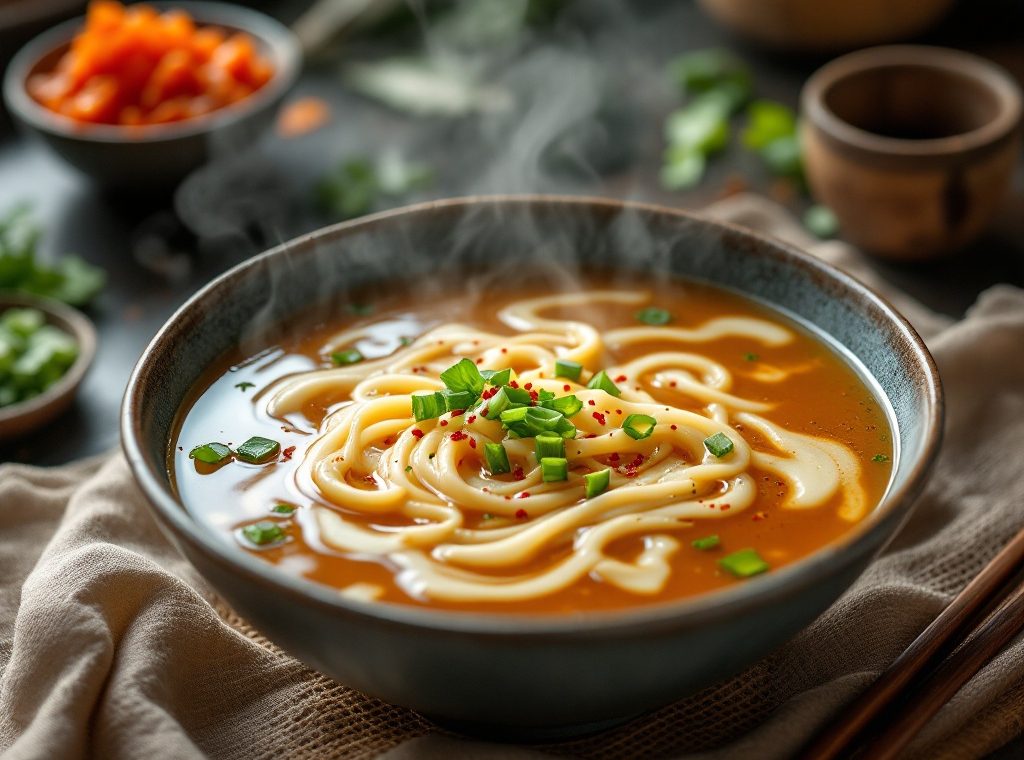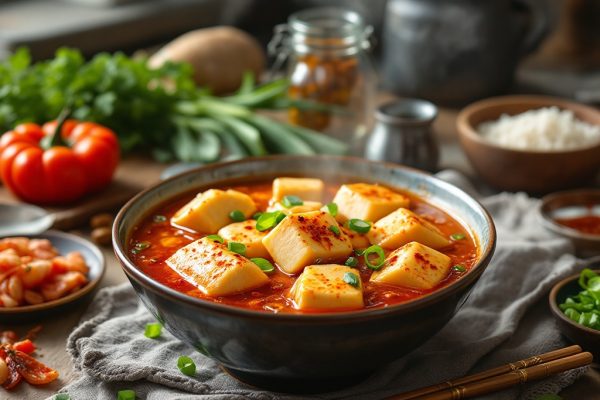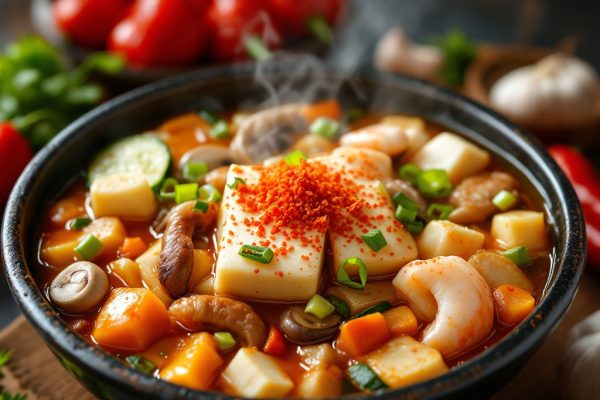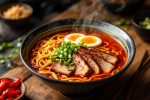Miso Egg Drop Soup: A Fantastic Dish Straight from Japan
Craving a flavorful, healthy meal that’s ready in under 15 minutes? Miso Egg Drop Soup elevates the classic with umami-rich miso paste and a spicy kimchi kick. This gluten-free, easily adaptable soup is perfect for a quick weeknight dinner. Discover how to make this flavorful and nutritious soup, from creating delicate egg ribbons to exploring vegetarian options, and learn why its unique umami flavor sets it apart. Dive into the recipe now!
Important information

- Miso paste gives the soup a rich umami flavor and depth.
- Kimchi adds a spicy kick to the soup (optional).
- It’s quick to make, ready in under 15 minutes.
- Naturally gluten-free and easily adaptable for vegetarians.
- Tofu, corn, spinach, and seaweed enhance the flavor and nutrition.
What Makes Miso Egg Drop Soup Unique?
What Makes Miso Egg Drop Soup Unique? Miso Egg Drop Soup elevates the classic with a rich, umami flavor from miso paste. This fermented soybean ingredient adds depth and complexity, while kimchi provides a spicy kick. This versatile soup is naturally gluten-free and easily adaptable for vegetarians, making it a perfect weeknight meal, often ready in under 15 minutes.
Umami Rich Flavors
Miso Egg Drop Soup delivers a savory, umami flavor thanks to the miso paste. Kimchi adds a tangy, fermented kick, while toasted sesame oil offers a nutty aroma. Ginger enhances the broth with a citrusy note, and a dash of white pepper contributes an earthy, floral hint. This fusion of flavors creates a rich, complex, and delicious soup.
Simple and Quick to Prepare
Whip up a flavorful Miso Egg Drop Soup in minutes. Perfect for a quick weeknight meal, this simple soup is ready in under 15 minutes. Boil the dashi, whisk in the miso paste, and gently drizzle in the eggs. A satisfying and flavorful meal is yours in about 10 minutes, with minimal effort and maximum taste.
Gluten-Free and Vegetarian Options
Naturally gluten-free, miso egg drop soup contains no wheat, barley, or rye, making it an excellent choice for people with celiac disease or gluten sensitivity. Vegetarians can easily adapt the recipe by swapping the chicken broth for vegetable broth, mushroom broth, or kombu dashi. Just ensure any miso paste added is vegetarian-friendly. Tofu, seaweed, and mushrooms are delicious additions to a vegetarian version.
Essential Ingredients for Miso Egg Drop Soup
Miso Egg Drop Soup gains its unique flavor from miso paste and kimchi. The broth can be dashi, chicken broth, or a vegetarian option. Whisking in eggs forms delicate ribbons and increases the protein content. Excellent additions include:
- tofu,
- corn,
- baby spinach.
Sesame oil, ginger, and white pepper enhance the taste. A sprinkle of fresh green onions makes a perfect garnish.
Miso Paste and Kimchi
Miso paste delivers the savory, umami depth to this Miso Egg Drop Soup. A spicy kick and fermented complexity can be added with kimchi, though the soup remains delicious even without it.
Broth: Dashi, Chicken Broth, or Alternatives
Dashi, a Japanese broth made from kombu (kelp) and bonito flakes, traditionally forms the base of Miso Egg Drop Soup, lending it a delicate umami flavor. For a richer, more savory taste, chicken broth is an excellent alternative. Vegetarians and vegans can achieve similar umami notes and satisfying depth with vegetable or mushroom broth.
Adding Flavor with Soy Sauce and Sake
Soy sauce and sake enhance the savory, umami notes of miso egg drop soup, complementing the miso and broth. These ingredients, while not traditional, add depth of flavor.
Using Eggs: Whisked Egg Ribbons
Drizzling beaten eggs into simmering miso soup creates delicate ribbons that enhance the soup in several ways. The gentle stirring forms thin, cooked strands, adding a silky texture and visual appeal. These ribbons also boost the soup’s nutritional value.
Optional Add-ins: Tofu, Corn, Baby Spinach, and More
Miso egg drop soup transforms into a flavorful and textured experience with the addition of tofu, corn, baby spinach, mushrooms, green onions, and seaweed. Tofu boosts the protein content, while corn adds a touch of sweetness. Spinach provides essential vitamins, and mushrooms offer an earthy depth. Green onions contribute a sharp bite, while seaweed lends a subtle savory note. This combination elevates the soup into a satisfying and nutritious meal.
Step-by-Step Guide to Making Miso Egg Drop Soup
In a pot, heat water or broth until it simmers.
In a separate bowl, whisk a little hot broth into miso paste until smooth.
Return the miso mixture to the pot.
Lightly whisk eggs and slowly drizzle them into the simmering soup while stirring continuously to create ribbons.
For a spicy kick, add kimchi.
Tofu, corn, or spinach are also delicious additions.
Adjust the soup’s consistency with more broth if needed.
Preparing the Broth
Warm your dashi or chicken broth in a pot until it simmers, creating a flavorful foundation.
In a separate bowl, whisk a bit of this hot broth with the miso paste to ensure a smooth consistency.
Pour this mixture into the main pot.
Incorporating Miso and Kimchi
Whisk the miso paste into the broth until fully dissolved. For a bolder, spicier flavor, add kimchi and mix thoroughly.
Creating the Perfect Egg Ribbons
To achieve perfect egg ribbons, whisk eggs in a bowl and slowly drizzle the mixture into simmering soup. Gently stir in a circular motion to create thin, delicate ribbons.
Achieving the Desired Soup Consistency
Manage your soup’s consistency by adding more or less broth. For a thicker soup, use less broth; for a thinner one, add more. Ingredients added early in the cooking process will also contribute to a thicker final product. Remember to taste and adjust seasonings throughout.
Comparing Miso Egg Drop Soup to Traditional Egg Drop Soup
Miso egg drop soup, or kakitamajiru, boasts a rich umami flavor thanks to its miso paste base. This contrasts with traditional egg drop soup’s lighter, savory taste. Both soups involve whisking eggs and drizzling them into hot broth, but their ingredients differ, creating unique experiences.
Miso Egg Drop Soup
Often includes ingredients like:
- Miso paste, providing a deep, fermented flavor.
- Dashi.
- Kimchi, for a spicy kick.
Traditional Egg Drop Soup
Favors simplicity, primarily using:
- Broth.
- Eggs.
- Seasonings like ginger or white pepper for a clean taste.
Flavor Profiles: Umami vs. Savory
Miso Egg Drop Soup delivers a potent umami flavor thanks to the savory, meaty taste of miso paste.
Traditional Egg Drop Soup, conversely, uses a simpler broth base, typically chicken broth, enhanced with aromatics.
This key distinction—the inclusion of miso—results in a richer, more complex, and ultimately more flavorful soup.
Ingredient Variations
Miso egg drop soup offers a flavorful twist on the classic recipe with the addition of miso paste and kimchi. Traditional egg drop soup typically uses a simple chicken or vegetable broth seasoned with ginger, garlic, and white pepper. This miso version, however, incorporates bold, fermented flavors, creating a key distinction between the two.
Cooking Techniques and Presentation
Whisk the eggs briskly and drizzle them slowly into the simmering miso broth while stirring gently to create delicate ribbons. Garnish with thinly sliced green onions for a classic touch, toasted sesame seeds for a nutty crunch, and a sprinkle of chili flakes for color and heat. A swirl of sesame oil enhances both the aroma and visual appeal.
Health Benefits and Nutritional Information
Miso Egg Drop Soup packs a powerful umami punch, boosting flavor and promoting satiety, which can be helpful for portion control. This incredibly versatile soup can be made with either chicken broth or vegetable broth for a vegetarian option. Using gluten-free miso paste ensures it’s enjoyable for everyone. Nutritionally, this soup offers numerous benefits depending on the additions. Miso provides gut-healthy probiotics, while eggs contribute protein. Adding tofu, vegetables, or seaweed enhances the nutritional value even more: spinach boosts iron, and seaweed offers iodine. Miso Egg Drop Soup is a delicious and nutritious meal.
Understanding the Umami Advantage
Umami, the fifth taste, offers a savory, meaty experience, reminiscent of a rich and satisfying broth. Distinct from sweet, sour, salty, and bitter, it adds depth to dishes. Ingredients like miso paste are packed with umami, enhancing flavor and enjoyment while potentially reducing the need for excess salt or unhealthy additives. Furthermore, studies suggest umami may contribute to feelings of fullness, influencing appetite regulation.
Nutritional Content and Dietary Considerations
Miso egg drop soup offers a healthy, low-calorie, and gluten-free meal option. Its adaptability for vegetarians further enhances its versatility.
Serving and Enjoying Miso Egg Drop Soup
Serve hot miso egg drop soup immediately after preparation. This versatile soup is perfect for a light meal, appetizer, or side dish. Pair it with steamed rice, noodles, or dumplings for a more substantial meal. Garnishes like chopped green onions, seaweed flakes, or a drizzle of sesame oil enhance both the flavor and presentation.
Best Occasions for Serving
Miso egg drop soup is a versatile dish, perfect for a light lunch, a casual dinner, or even a simple appetizer.
Pairing with Other Dishes
Miso Egg Drop Soup pairs perfectly with various dishes. It complements rice dishes, especially Japanese fried rice. It’s also delicious with dumplings, spring rolls, or a fresh salad. For a heartier meal, enjoy it with Korean sticky chicken or a vegetable stir-fry. This versatile soup is a light main course in Japanese and other Asian cuisines. It also makes a flavorful side dish, adding a comforting touch to noodle dishes.
Garnishing Ideas for Enhanced Flavor
Fresh green onions, toasted sesame seeds, and a drizzle of chili oil are typical garnishes for miso egg drop soup, creating a visually appealing dish while enhancing its flavor profile. The green onions provide a refreshing bite, the sesame seeds offer a nutty aroma and satisfying crunch, and the chili oil adds a touch of heat. For a different twist, try a swirl of sriracha or some crispy wonton strips for added texture.
Storing and Reheating Tips for Miso Egg Drop Soup
Store leftover miso egg drop soup in an airtight container, and refrigerate for up to four days. Reheat gently on the stovetop over low heat, being careful not to boil. If it thickens, add a little water while reheating.
Preserving Freshness
Store your miso egg drop soup in an airtight container in the refrigerator and enjoy it within two or three days to maintain its best flavor.
Reheating Without Compromising Taste
Gently warm your miso egg drop soup over low heat, stirring frequently to prevent scorching and ensure even heating. This slow method protects the delicate egg ribbons and preserves the soup’s delicious flavor.














